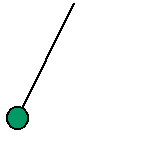In the formula
period T is proportional to the length l.
This means that T decreases when l decreases,
and T increases when l increases.
• So to correct a clock that is running a little fast,
we wish to increase T. Hence we increase l a little.
• If the length of the pendulum is doubled,
l is replaced by 2l.
This means that T is increased by a factor of ![]() 2.
2.
Similarly, if l is halved, T is decreased;
the new value is T /![]() 2.
2.
In the formula ![]() we notice that the
we notice that the
period T is inversely proportional to the gravity g.
This means that for a given, fixed length l,
T increases when g decreases.
• So if T is to remain the same when the clock
is on the moon, the length l will also
have to be decreased,
and in fact proportionally to the change in gravity.


 • If a pendulum clock were taken to the moon (for which the value of g is less), how would the pendulum length need to be altered for the clock to run at the correct speed?
• If a pendulum clock were taken to the moon (for which the value of g is less), how would the pendulum length need to be altered for the clock to run at the correct speed?